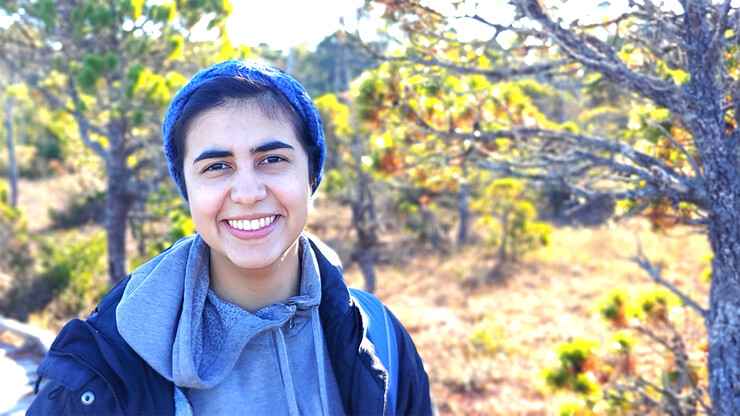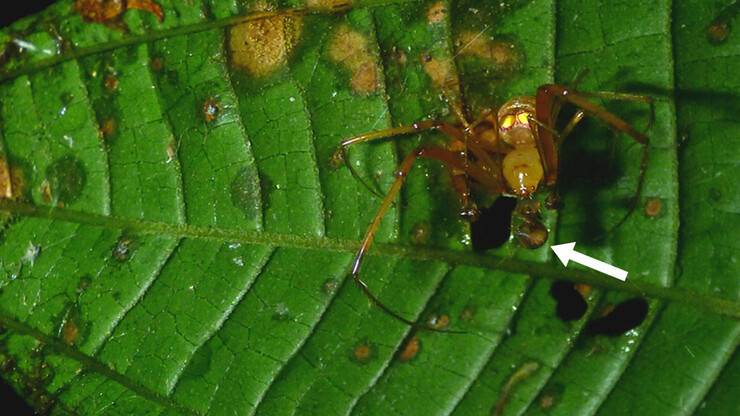Scott Schrage, November 28, 2023
Silk lines help pirate spiders trick, capture eight-legged prey
‘IT’S WORKING AS A SPIDER WEB FOR CATCHING SPIDERS’
Headlamps alone illuminated the trail bisecting the Costa Rican rainforest. Having waded the black of the Tirimbina reserve so often before, Gilbert Barrantes, Laura Segura Hernández and Diego Solano Brenes knew the routine.
It was time, dusk informed the surrounding spiders, to let loose the wind-aided, floating lines of silk that might latch onto leaf, branch or ground, fortifying the first beams of the food-snaring webs to come. But even on a night so familiar, the team would encounter a hunting scene unfamiliar not just to these arachnologists, in this forest, but all of them, anywhere.
“It was completely serendipitous,” said Segura Hernández, who earned her doctorate from the University of Nebraska–Lincoln in August.
What the trio stumbled on was a trap: lines floated not for framing but for fishing, part of a gambit that gives other forest-dwelling spiders just enough silk to hang themselves. And at the center of the scheme, not to mention the lines? A venomous pirate.
Four lines of that silk, the researchers realized, were running horizontally and diagonally from the underside of the same leaf. From elsewhere, the end of another thread had drifted in and caught on one of those leaf-dangling lines. That thread was the product of a spiderling now skittering along it to inspect the joint and, with its silken pillar secured, commence the construction of a full-fledged web.
“And then,” Segura Hernández said, “we just saw this other spider shoot in out of nowhere.”

The interloper was Gelanor siquirres, a species from the family known as pirate spiders — named for their willingness to invade already-built spider webs, strategically pluck threads to draw out their eight-legged inhabitants, and dine on them. This was something different. This G. siquirres emerged from its hiding spot beneath the leaf, scuttled across its own floating line, paralyzed its harried, hapless prey with a bite, then retreated to the leaf with the spiderling clutched in its ultra-long jaws.
A close look at that leaf would reveal the swashbuckler’s identity. A close look at the research literature would reveal that no one had ever reported the devious hunting technique, which the team has since witnessed multiple times. With a recent paper in the journal Animal Behaviour, the Tirimbina-trekking team would become the first.
“It’s working as a spider web for catching spiders,” Segura Hernández said of the lines floated by G. siquirres, which, like its pirate brethren, does not build circular webs. “That’s one of the cool things about it.”
Not the only thing, though. Pirate spiders are known as slow, deliberate killers: While venturing onto another spider’s web, Segura Hernández said, some pirates might advance no more than a few centimeters in an hour, lest they risk triggering any unwanted vibrations. The stealth makes sense when considering that the prey are also accomplished predators with venom of their own, and that G. siquirres, at no more than a half-inch long, is more David than Goliath.
Yet when another spider approaches one of its floating lines, G. siquirres darts forward with an alacrity that initially stunned Segura Hernández and her colleagues — the equivalent of a sloth turning cheetah.
“So it’s not just a modification of web-building behavior,” she said. “It’s a modification of the spider’s locomotion, as well.”
Video of a pirate spider capturing a smaller arachnid before retreating to a leaf
G. siquirres seems to have adapted its schedule, too, getting an early start to ensure that its floating lines are in place by the time its potential prey is releasing its own.
“It’s not like spiders make webs all night,” Segura Hernández said. “There’s clearly a peak period of activity, right after dark, where you see all of these floating lines on the trail. So it’s not like (G. siquirres) can do this in the morning. They are targeting this specific time period.”
There remains a lot to learn about G. siquirres, which was officially described and named in 2016 but had not, until now, been the subject of any peer-reviewed research. The fact that the first G. siquirres behavior ever documented happens to double as a behavior never seen in any spider speaks to how much remains unknown about the eight-legged wonders as a whole, Segura Hernández said, especially those residing in prey-rich rainforests.

For her, it also underscores the value of not overlooking observation itself, of remembering to seek ideas, questions and answers not just in pages but the wild. She hasn’t forgotten the words of Bill Eberhard, who mentored her as an undergrad at the University of Costa Rica and was commemorated in the same journal issue that features the G. siquirres study.
“One of my favorite things about this paper is that it highlights how important it is — what Bill Eberhard taught us — to observe and just pay attention to detail,” she said. “Sometimes people are so focused on hypotheses and questions that they kind of forget about the organisms. But I think both things are equally important.
“Can we even envision how many more incredible hunting strategies there are just waiting to be observed?”
It was that spirit, in part, that encouraged her to spend so much time wandering in Tirimbina. At this point, she can’t recall any specific reason that she and the others were out that fateful night. Not that she needed one. The rainforest itself — the trill of insects and pattering of lizards, the aromas of wildflowers floating, like the spider silk, on a breeze — offered its own draw.
“Everything is alive. And at night, it has a mystery. You realize how much you rely on vision, because you’re restricted to what your headlamp can show.
“But that one time, we were just walking down the trail, talking about something,” she said, “and then we noticed the silk.”





